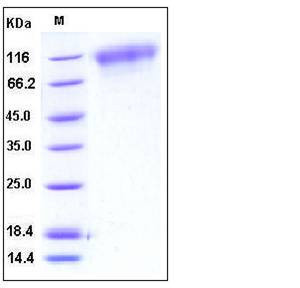Mouse TrkC / NTRK3 Protein (His Tag)
AW125844,Ntrk3_tv3,TrkC
- 100ug (NPP3527) Please inquiry
| Catalog Number | P50320-M08H |
|---|---|
| Organism Species | Mouse |
| Host | Human Cells |
| Synonyms | AW125844,Ntrk3_tv3,TrkC |
| Molecular Weight | The secreted recombinant mouse TrkC comprises 409 amino acids and has a calculated molecular mass of 46.1 kDa. As a result of glycosylation, the recombinant protein migrates as an approximately 100-110 kDa band in SDS-PAGE under reducing conditions. |
| predicted N | Cys 32 |
| SDS-PAGE |  |
| Purity | > 95 % as determined by SDS-PAGE |
| Protein Construction | A DNA sequence encoding the extracellular domain of mouse TrkC (NP_032772.3) (Met 1-Thr 429) was expressed, with a C-terminal polyhistidine tag. |
| Bio-activity | Immobilized mouse NTRK3-His at 10 μg/ml (100 μl/well) can bind biotinylated human NT3 (P10286-HNA), The EC50 of biotinylated human NT3 (P10286-HNA) is 0.04-0.08 μg/ml. |
| Research Area | Immunology |Signal Transduction |Protein Kinase |Receptor Tyrosine Kinase (RTK) |
| Formulation | Lyophilized from sterile PBS, pH 7.4 1. Normally 5 % - 8 % trehalose, mannitol and 0.01% Tween80 are added as protectants before lyophilization. Specific concentrations are included in the hardcopy of COA. |
| Background | NT-3 growth factor receptor also known as neurotrophic tyrosine kinase receptor type 3 or TrkC tyrosine kinase or Trk-C receptor, is a member of the neurotrophic tyrosine receptor kinase (NTRK) family. This kinase is a membrane-bound receptor that, upon neurotrophin binding, phosphorylates itself and members of the MAPK pathway. TrkC/NTRK3 is widely expressed in the developing and adult nervous system. In later embryonic development, TrkC/NTRK3 is expressed in various structures of the CNS including the caudatoputamen, septal nuclei, cerebellum, and brainstem. Other neurotrophins include nerve growth factor(NGF), neurotrophin-3 and neurotrophin-4. In the PNS, trkC hybridization appears to correlate, both temporally and spatially, with the outgrowth of axons toward their peripheral targets. TrkC/NTRK3 is widely expressed in the three identified branches of the mammalian nervous system and appears to correlate with the expression of NT-3, its cognate ligand. The apparent colocalization of trkC transcripts with NT-3 raises the possibility this neurotrophin exerts its trophic effects by a paracrine and/or autocrine mechanism. Signalling through this kinase leads to cell differentiation and may play a role in the development of proprioceptive neurons that sense body position. Mutations in TrkC encoding gene have been associated with medulloblastomas, secretory breast carcinomas and other cancers. |
| Reference |
